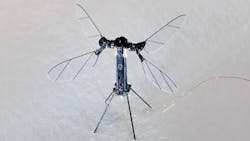2.6-inch insect-like unmanned aerial vehicle (UAV) weighs 259 milligrams, yet is not ready to fly outside
CAMBRIDGE, Mass. – A solar-powered winged robot has become the lightest machine capable of flying without being attached to a power source. New Scientist reports. Continue reading original article
The Military & Aerospace Electronics take:
1 July 2019 -- Weighing just 259 milligrams, the insect-inspired RoboBee X-Wing unmanned aerial vehicle (UAV) has four wings that flap 170 times per second. It has a wingspan of 1.4 inches and stands 2.6 inches high.
The flying robot was developed by Noah Jafferis and his colleagues at Harvard University. Its wings are controlled by two muscle-like plates that contract when voltage passes through them. They are powered by six tiny solar cells weighing 10 milligrams each, which are located above the wings so as not to interfere with flight.
The insect robot’s wings begin flapping when exposed to light. Currently, it has only been tested in the lab, where it is powered by a combination of halogen and LED lighting, says Jafferis. The robot currently requires the equivalent of three times the intensity of natural sunlight, so isn’t yet able to fly outside.
Related: Small payloads with big performance
John Keller, chief editor
Military & Aerospace Electronics

